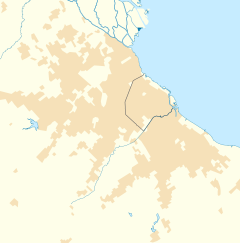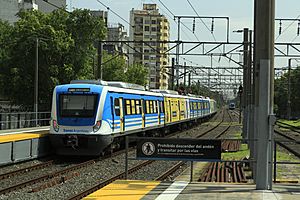Lanús facts for kids
Quick facts for kids
Lanús
|
|
|---|---|
| Country | |
| Province | |
| Partido | Lanús |
| Founded | October 20, 1888 |
| Elevation | 9 m (30 ft) |
| Population
(2010 census [INDEC])
|
|
| • Total | 212,152 |
| Demonym(s) | lanusense |
| CPA Base |
B 1824
|
| Area code(s) | +54 11 |
| Patron saint | Santa Teresa de Jesus |
Lanús is a city in Buenos Aires Province, Argentina. It's the main city of Lanús Partido. You can find it just south of Buenos Aires, the capital city. Lanús is part of the big Greater Buenos Aires area. In 2001, about 212,152 people lived in the city. The whole Lanús Partido had a population of 453,500.
Contents
What is Lanús Like?
Lanús is a busy place with many factories. It has train lines for both goods and people. The city makes many things like chemicals, textiles, paper, and leather items. They also produce oils, lubricants, and even weapons.
You can find several technical schools here. There is also the Eva Perón Medical Center. This is one of the biggest hospitals in the Greater Buenos Aires area.
Lanús is famous for its football team, Club Atlético Lanús. They play in Argentina's top football league. The club also has a basketball team.
A person named Guillermo Gaebeler started to develop the town. He planned its first layout on October 20, 1888. He called it Villa General Paz. Streets and plazas were named after battles won by General José María Paz. In 1955, the city was officially renamed Lanús. This was to honor Anacarsis Lanús, who owned the land before he died in 1887.
Lanús Through Time
Early History: Indigenous People
Before the Spanish arrived, different native tribes lived in the area of Lanús. These included the Pampas and the Guarani. The Pampas were nomads, meaning they moved around a lot. They lived on the vast plains and hunted animals for food. They used tools like bows and arrows.
The Guarani people, especially those near the Plata River, lived in one place. They traveled in large canoes. They were good at weaving and making pottery from cotton. When the Spanish came, they found Guarani villages along the river.
Colonial Times
The city of Buenos Aires was first started in 1536. Some historians believe this first settlement was near where Lanús is today. But this first attempt didn't last long. Buenos Aires was permanently founded in 1580 by Juan de Garay.
Juan de Garay gave out land to people to encourage them to settle. The land that is now Lanús was part of bigger areas called "payments." Early landowners didn't stay, so their lands were given to other settlers.
Becoming Independent
Around 1856, about 5,099 people lived in the district. Many were from other countries like France, Spain, and Italy. Most people worked in meat processing factories or on farms. There were also bakeries, stores, and taverns.
There were a few schools and chapels. Most houses were simple, made of brick or with thatched roofs.
Separating from Avellaneda
For many years, people wanted Lanús to be its own district. A group called "Unión Vecinal Autonomista" worked hard for this. They used the number 111 as their symbol.
Lanús officially became an independent district on January 1, 1945. It was the 111th district in Buenos Aires province. Before this, it was part of the Avellaneda district. It was called "4 de junio" (June 4th) at that time.
On June 13, 1945, the area grew bigger. Remedios de Escalada, known for its train workshops, joined Lanús. This area used to be part of Lomas de Zamora.
In 1955, the government changed the name "4 de junio" to "Lanús." This name is still used today.
The first local newspaper, "La Comuna," started in 1910. The Juan Bautista Alberdi library opened nine years later. It now has 22,000 books. The city's own library, started in 1949, has 11,000 books and magazines.
In 1986, a memorial called "Plazoleta Héroes de Malvinas" was opened. It honors those who died in the Malvinas War.
Lanús is also home to a large hospital, "Hospital Interzonal General de Agudos Evita." It opened in 1952 and treats patients from many areas. There are also private clinics like Modelo and Estrada.
Since 1983, when democracy returned, Manuel Quindimil was the mayor for a long time. He was also mayor from 1973 to 1976. In 2007, Darío Díaz Pérez became the new mayor. Currently, Néstor Grindetti is the mayor of Lanús.
Famous People from Lanús
Many well-known people are from Lanús, including:
- Horacio Accavallo - a boxer
- Luca Andrada - a professional football player
- Hugo Arana - an actor
- Alfredo Arias - a theatre producer
- Gustavo Cordera - a rock musician
- Diego Maradona - a football legend and star of the 1986 World Cup
- Ricardo Montaner - a famous Latin musician
- Sandro - a popular singer
- Babasónicos - a rock band
- Gastón Fernández - a football player
- Diego Valeri - a football player for Club Atlético Lanús
- Walter Montillo - a football player
- Adrian Ricchiuti - a football player
- Marcela Morelo - a Latin singer and composer
- Julie Gonzalo - an actress
- Francisco Álvarez - an actor
- Ariel González - a rock musician and songwriter
- Sergio Olguín - a writer and journalist who wrote a novel called Lanús
- Emanuel Moriatis - a racing driver
- Emiliano Spataro - a racing driver
See also
 In Spanish: Lanús para niños
In Spanish: Lanús para niños



